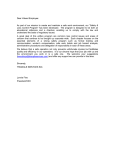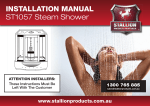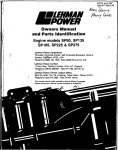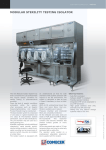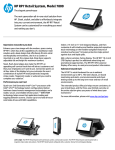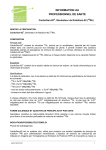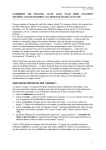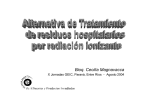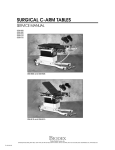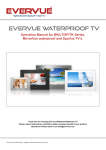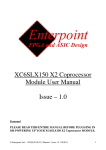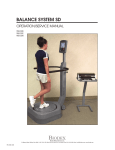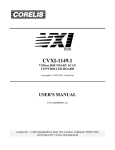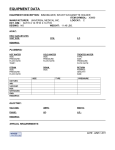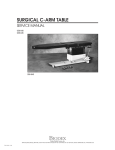Download Bracco`s Rb-82 Generator
Transcript
2014 Meeting of Mid-Atlantic States Radiation Control Programs Brian Cherundolo, BS, RT(R), CNMT Sr. Clinical Applicants Specialist Bracco Diagnostics Inc. Objectives • Describe CardioGen-82 Indication and Technical Aspects • Review the Product Recall and Back-to-Market Objectives • Review the Updated Prescribing Information • Review CardioGen-82 Daily Quality Control • Identify advantages of Cardiac PET CardioGen-82 Indication and Technical Aspects Indication and Usage • CardioGen-82 is a closed system used to produce rubidium Rb 82 chloride injection for intravenous use. Rubidium Rb 82 chloride injection is a radioactive diagnostic agent indicated for Positron Emission Tomography (PET) imaging of the myocardium under rest or pharmacologic stress conditions to evaluate regional myocardial perfusion in adult patients with suspected or existing coronary artery disease. • CardioGen-82 is not indicated for use with pediatric patients • Contraindications: None 1. CardioGen-82® (Rubidium Rb 82 Generator) Prescribing Information. Princeton, NJ: Bracco Diagnostics Inc.; February 2012. Dosage and Administration • Use CardioGen-82 only with an infusion system specifically designed for use with the generator and capable of accurate measurement and delivery of doses of rubidium Rb-82 chloride injection. • The recommended adult (70 kg) dose of rubidium Rb-82 chloride injection is: • 1480 MBq (40 mCi), with a range of 1110-2220 MBq (30-60 mCi) infused intravenously at a rate of 50 mL/minute, not to exceed a total volume of 100 mL • Do not exceed a single dose of 2220 MBq (60 mCi) • Use the lowest dose necessary to obtain adequate cardiac visualization consistent with the dosing goal of as low as reasonably achievable (ALARA) 1. CardioGen-82® (Rubidium Rb 82 Generator) Prescribing Information. Princeton, NJ: Bracco Diagnostics Inc.; February 2012. 5 Prescribing Information • Dosage Forms and Strengths (section 3) • CardioGen-82 is a closed system used to produce rubidium Rb 82 chloride injection for intravenous use. CardioGen-82 consists of strontium Sr-82 adsorbed on a hydrous stannic oxide column with an activity of 90-150 millicuries Sr-82 at calibration time. 1. CardioGen-82® (Rubidium Rb 82 Generator) Prescribing Information. Princeton, NJ: Bracco Diagnostics Inc.; February 2012. Technical Aspects • Contains Sr-82 and Sr-85 in a lead shielded hydrous stannic oxide column - Sr-82 half-life is 25 days (parent isotope) - Sr-85 half-life is 65 days (unintended byproduct) • The “daughter” is Rb 82 chloride - Half-life 75 seconds • Rb 82 kinetics: - Potassium analog - After IV injection, Rb 82 rapidly clears the blood - Activity in myocardium within first minute - Defects visualized 2-7 minutes after injection - High extraction fraction at high flow rates - Must be used with the Infusion System • Same quantity dose for rest and stress imaging • On-demand availability 1. CardioGen-82® (Rubidium Rb 82 Generator) Prescribing Information. Princeton, NJ: Bracco Diagnostics Inc.; February 2012. CardioGen-82 Infusion System • Provides automated dose delivery system6 • Two shielding vaults2 - CardioGen-82 - Waste container • A scintillator for determining dose activity6 • Elute with additive-free 0.9% Sodium Chloride Injection USP only1 • Quality control6 - Daily column wash - Rb 82, Sr-82 and Sr-85 level testing daily prior to patient administration and additionally daily every 750 mL after detection of an Alert Limit1 - Daily calibration 1. CardioGen-82® (Rubidium Rb 82 Generator) Prescribing Information. Princeton, NJ: Bracco Diagnostics Inc.; February 2012. 2. CardioGen-82® (Rubidium Rb 82 Generator) Infusion System User's Guide. CardioGen-82 Infusion System: Fluid-System Design 2. CardioGen-82® (Rubidium Rb 82 Generator) Infusion System User's Guide. CardioGen-82 Infusion System: Shielding Photo courtesy of RbM Services CardioGen-82 Infusion System: Syringe Pump Photo courtesy of RbM Services CardioGen-82 Infusion System: Valve Shield Assembly Photo courtesy of RbM Services CardioGen-82 Infusion System: Display/Control Panel Photo courtesy of RbM Services Recall / Back-To-Market Overview February 2, 2012 Why was CardioGen recalled? • Early Summer 2011, 2 individuals entering the U.S. triggered gamma ray emissions sensors that detected radiation that was analyzed to have come from strontium-82 (Sr-82) and strontium-85 (Sr-85) • Weeks before, these 2 individuals had undergone CardioGen-82 MPI at 2 different clinical user sites, one in Las Vegas and the other in Sarasota 15 Why was CardioGen recalled? • Homeland Security notified the Department of Energy • Department of Energy officials notified Bracco • Bracco reported the 2 incidents as expedited AE reports to the FDA • Bracco met with FDA on July 22, and presented the information it had to date (which indicated product misuse at the 2 sites), steps it was taking and would take to address the issue and the FDA inspection findings, and information about the clinical value of CardioGen 16 Why was CardioGen recalled? • Subsequent to the meeting, Bracco voluntarily recalled and suspended distribution of CardioGen-82, while: - Further investigating the root causes of these two reports of unexpected radiation exposure from CardioGen-82 - And began a 6-month process of near constant interaction with various divisions of the FDA, and (to a lesser extent) with the NRC and agreement states 17 CardioGen-82 Reintroduction Plan • Test the recalled generators • Investigate patients at risk for excessive Sr-82/Sr-85 exposure • Re-validate the manufacturing process • Update the prescribing information • Develop and implement QC monitoring program 18 Recall Generator Testing Observations • The 113 recalled generators that were tested were between 28-54 days from the date of calibration - Not all returned generators were testable – some had been allowed to dry out, others were > 2 months beyond calibration) • These generators reflected a wide range of field usage conditions for both patient dose and elution volume • They also reflected rigorous transport conditions: not only original shipping to individual sites, and use in mobile PET vehicles, but also the return-to-LANL shipment procedure • Results: None of the 113 returned testable generators showed excessive Sr breakthrough – i.e., none were defective 19 Clinical Assessments after Recall • FDA required Bracco to perform clinical assessments of the scope and severity of Sr-82/Sr-85 exposure to patients receiving CardioGen-82 • Accordingly, FDA directed that two types of clinical studies be done: - An investigation of high-risk patients from the two clinical user sites (Las Vegas and Sarasota) - A more general survey of patients from all other clinical user sites • Please refer to www.cardiogen.com for updates regarding the clinical studies 20 The Root Cause: from the FDA’s Safety Announcement of Jan 12, 2012 • “The preliminary information from the investigations suggests that improper usage of CardioGen-82 at certain clinical sites is responsible for the exposure of some patients to more radiation than is typically associated with a CardioGen-82 scan. This increased radiation exposure was due to the administration of CardioGen-82 generator eluates that contained excessive concentrations of strontium-82 (Sr-82) and strontium-85 (Sr-85). This excessive release of Sr-82 and Sr-85 in generator eluates is known as "strontium breakthrough." FDA believes it is unlikely that this excessive exposure posed significant risks to patients, though exposure to any excessive radiation is undesirable.” 21 Return to Market Requirements – from FDA • Successful Conduct of Quality and Clinical Root Cause Investigations (previous slides) • Revalidate Manufacturing Process • Develop new Product Labeling with additional safety measures • Implement new QC user monitoring program to be run by Bracco 22 Updated Prescribing Information (PI) 23 New statement in revised PI reflects FDA findings • In WARNINGS AND PRECAUTIONS - Section 5.1 – 2nd sentence ■ “Unintended exposure to strontium radiation has occurred in some patients who received rubidium Rb 82 injections at clinical sites where generator eluate testing appeared insufficient.” 1. CardioGen-82® (Rubidium Rb 82 Generator) Prescribing Information. Princeton, NJ: Bracco Diagnostics Inc.; February 2012. 24 CardioGen-82 Labeling Revisions • Additional warnings re strontium breakthrough potential: • New Boxed Warning - Warns of unintended radiation exposure to Sr-82 & Sr-85 - Instructs user to record cumulative eluate volume (which may trigger an alert or product expiration – see below) - Establishes new Alert Limits, and requires additional testing if and when any of these limits are reached - Establishes new Expiration Limits • Update of WARNINGS AND PRECAUTIONS section - Section 5.1: Unintended Sr-82 and Sr-85 exposure 1. CardioGen-82® (Rubidium Rb 82 Generator) Prescribing Information. Princeton, NJ: Bracco Diagnostics Inc.; February 2012. 25 Old and New Limits • Breakthrough limits: - 0.02 μCi Sr-82 / mCi Rb 82 or - 0.2 μCi Sr-85 / mCi Rb 82 • These remain a part of federal regulations (10 CFR 35:204) as well as a part of the Prescribing Information (Section 11.1) 1. CardioGen-82® (Rubidium Rb 82 Generator) Prescribing Information. Princeton, NJ: Bracco Diagnostics Inc.; February 2012. CardioGen-82 Labeling Revisions • New Product “Expiration Limits” - Sr-82 level exceeds 0.01 μCi Sr-82/mCi Rb-82, or - Sr-85 level exceeds 0.1 µCi Sr-85/mCi Rb-82, or - A total elution volume of 17 L has passed through the generator column, or - 42 days post calibration date • NOTE: The Expiration Limits for Sr-82 and Sr-85 levels are ½ the legal breakthrough limits, continuing to provide a wide safety margin. 1. CardioGen-82® (Rubidium Rb 82 Generator) Prescribing Information. Princeton, NJ: Bracco Diagnostics Inc.; February 2012. 27 CardioGen-82 Labeling Revisions • New product “Alert Limits” - Sr-82 level exceeds 0.002 µCi Sr-82/mCi Rb-82, or - Sr-85 level exceeds 0.02 µCi Sr-85/mCi Rb-82, or - A total elution volume of 14 L has passed through the generator column • These are now the limits at which the clinical site must monitor additional generator elution volume and perform another test for Sr-82/Sr-85 levels each time an additional 750 ml has been eluted from the generator on a given alert day. • NOTE: The Alert Limits for Sr-82 and Sr-85 levels are 1/10 the legal breakthrough limits (which are established in 10 CFR 35:204); this provides a wide margin of safety at the onset of increased vigilance. 1. CardioGen-82® (Rubidium Rb 82 Generator) Prescribing Information. Princeton, NJ: Bracco Diagnostics Inc.; February 2012. 28 Directions for Eluting (section 2.4) • Was previously section 2.6 • Adds a new warning about “additives”, particularly calcium ions, which may cause the release of substantial amounts of Sr-82 and/or Sr-85, regardless of any other considerations - NOTE: For example, Lactated Ringer’s solution, which contains large amounts of calcium ions, should NEVER be used for Rb 82 elution. • Adds a new instruction to maintain an on-going record of all elution volumes - This refers not only to patient doses, but to all eluate that goes through the generator, including that used for column washing and strontium level testing 1. CardioGen-82® (Rubidium Rb 82 Generator) Prescribing Information. Princeton, NJ: Bracco Diagnostics Inc.; February 2012. Ongoing Compliance Program • The adherence of sites to the new quality control provisions of the revised CardioGen-82 PI must be monitored by Bracco (as per FDA) • Sites are required to submit daily to Bracco - QC documentation (re column wash, Sr testing, calibration) and - Accounting of total elution volume passed through the generator column • Bracco instituted an on-line electronic data entry system to eliminated paper/fax reporting • Site training, certification, etc. measures are required • FDA expects Bracco to take action if sites are not compliant, such as: - Retraining, additional knowledge assessments - Termination as a CardioGen-82 customer • Monitoring data is reported monthly to FDA (& NRC & agreement states) 30 Quality Control (QC) Procedures Dose Calibrator QC • The NRC or NRC Agreement States requires that instruments be calibrated in accordance with nationally recognized standards or the manufacturer’s instructions3 • Calibration Tests include:4 - Accuracy - Linearity - Geometry - Constancy 3. Nuclear Regulatory Commission (NRC), Chapter 1 of Title 10, Energy of the CFR, Part 35.60. 4. Academic Affairs Committee, SNMTS. (2003). Performance and responsibility guidelines. JNMT, 31(4), 222-229. Dose Calibrator Settings for Rb 82 • For Rb 82 assays: • Determine if the dose calibrator has a Rb 82 pre-set channel - If there is no setting for Rb 82, use the setting for Co-60 and a mathematical correction factor • Program dose calibrator for Rb 82 as recommended by the manufacturer - Biodex: AtomLab 100 = 8.85 ; AtomLab 400/500 = 8.76 - Capintec: 5047 - Check user manual for setting specifics • The facility must have a dose calibrator capable of reading microcuries (uCi) and out to 2 decimal places8 5. Biodex Medical Systems. Supplemental Alphabetical Listing of Isotopes AtomLab Dose Calibrators. 1-7. 6. Biodex Medical Systems. Supplemental Alphabetical Listing of Isotopes AtomLab 400 and AtomLab 500 Dose Calibrators. Rev. 4-20-09, 1-6. 7. Capintec User’s Manual, July 2007 Appendix II A2-9. 8. Standard Operating Procedures for the Training and Certification of Individual Using CardioGen-82 (2012). CardioGen-82 QC Preparation • Aseptic techniques should be employed throughout each procedure • Waterproof gloves are to be worn • Survey the waste bottle and empty the contents every morning in accordance with department radiation safety regulations • Allow 10 minutes between elutions • Elute only with additive-free, 0.9% sodium chloride injection USP 2. CardioGen-82® (Rubidium Rb 82 Generator) Infusion System User's Guide. CardioGen-82 QC Procedures • Three Step QC Procedure: W-S-C - 1st Elution: Generator Column Wash (W) - 2nd Elution: Sr-82 and Sr-85 Level Testing (S) - 3rd Elution: Infusion System Calibration (C) 2. CardioGen-82® (Rubidium Rb 82 Generator) Infusion System User's Guide. CardioGen-82 Infusion System QC 1st Elution: Generator Column Wash (W) - This prepares the column for use - Performed with a 50 mL elution - Performed daily 2. CardioGen-82® (Rubidium Rb 82 Generator) Infusion System User's Guide. 1st Elution: The Generator Column Wash 1. Label elution test vial with “W”, current date, time, and initial of technologist performing test 2. Place elution test vial into the vial shield 3. Attach a 18-20 gauge needle to the patient administration set 4. Insert the needle into the shielded elution test vial septum 5. Insert a vent needle into the shielded elution test vial septum (make sure it does not extend below the 50 ml fill point) 6. Set the patient dose to 99 mCi 7. Set the patient volume to 50 ml 8. Confirm the infusion mode is set to automatic infusion 9. Confirm the syringe pump is properly filled 10. Start infusion by pressing the “Inject Start/ Stop” button. 11. (observe ALARA principles) 12. Allow for adequate decay and discard the eluate vial according to department radiation safety regulations 13. Label Infusion System printout with date, infusion time, user initials and “W”. Save printout for volume tracking. 2. CardioGen-82® (Rubidium Rb-82 Generator) Infusion System User's Guide. Rev. 20, October 2012. 1st Elution: The Generator Column Wash Control Panel Settings h Mode Switch Automatic Infusion Elution Volume 99 ml Patient Volume 50 ml Patient Dose 99 mCi Dose Rate 1mCi/sec Flow Rate 50 ml/min CardioGen-82 Infusion System QC 2nd Elution: Sr-82 and Sr-85 Level Testing (S) - Measurement of Sr-82/Sr-85 levels in the eluate - Measured as the ratio of Sr-82 or Sr-85 to Rb 82 activity - uCi/mCi - Performed daily prior to patient administration and at additional daily tests after reaching any ONE of the Alert Limits (see Prescribing Information)1 - Additional daily tests every 750 mL elution volume 1. CardioGen-82® (Rubidium Rb 82 Generator) Prescribing Information. Princeton, NJ: Bracco Diagnostics Inc.; February 2012. 2. CardioGen-82® (Rubidium Rb 82 Generator) Infusion System User's Guide. 2nd Elution: Sr-82 and Sr-85 Level Test 1. Allow 10 min to elapse for isotope regeneration. 2. Label elution test vial with “S”, current date, time, and initial of technologist performing test 3. Place elution test vial into the vial shield 4. Attach an 18-20 gauge needle to the patient administration set 5. Insert the needle into the shielded elution test vial septum 6. Insert a vent needle into the shielded elution test vial septum (make sure it does not extend below the 50 ml fill point) 7. Set the patient dose to 99 mCi 8. Set the patient volume to 50 ml 9. Confirm the infusion mode is set to automatic infusion 10. Confirm the syringe pump is properly filled 11. Start infusion by pressing the “Inject Start/ Stop” button 2. CardioGen-82® (Rubidium Rb-82 Generator) Infusion System User's Guide. Rev. 20, October 2012. 2nd Elution: Sr-82 and Sr-85 Level Test Collect and assay a 50 ml sample of Rb-82: 12. When the infusion light goes out, start a timer 13. Take the shielded vial to the dose calibrator for assay 14. Assay the eluate vial at 3 min and 45 sec and record the dose calibrator reading* 15. Correct the dose assay for decay to the End Of Elution (EOE) • Multiply the dose calibrator reading by the appropriate decay factor 16. Set shielded vial aside to measure for Sr-82/Sr-85 levels at 60 min post EOE 17. Label Infusion System printout with date, infusion time, user initials and “S”. Save printout for volume tracking * Additional times are available 2. CardioGen-82® (Rubidium Rb-82 Generator) Infusion System User's Guide. Rev. 20, October 2012. 2nd Elution: Sr-82 and Sr-85 Level Test 18. Perform a dose calibrator background check prior to assay. 19. Assay the eluate vial at 60 minutes post EOE, allow eluate to stabilize 100 to 200 seconds before recording. 20. Record the dose calibrator reading in uCi, out to two decimal places. 21. Calculate the level of Sr-82 using the Sr-82/Sr-85 level worksheet. Sr-82 content must not be more than 0.01 uCi/mCi of Rb-82 22. Calculate the level of Sr-85 using the Sr-82/Sr-85 level worksheet. Sr-85 content must not be more than 0.1 uCi/mCi of Rb-82 23. If levels are above the allowable limits, discontinue use of the generator immediately and contact Bracco Diagnostics Inc. 24. Diligent record keeping and retention of the worksheet must be in compliance with Bracco policies as well as in accordance with individual departmental policies 25. Allow for adequate decay and discard the eluate vial according to department radiation safety regulations 2. CardioGen-82® (Rubidium Rb-82 Generator) Infusion System User's Guide. Rev. 20, October 2012. 2nd Elution: The Sr-82 and Sr-85 Level Test Control Panel Settings Mode Switch Automatic Infusion Elution Volume 99 ml Patient Volume 50 ml Patient Dose 99 mCi Dose Rate 1mCi/sec Flow Rate 50 ml/min Sr Level QC Worksheet Sample CardioGen-82 Infusion System QC 3rd Elution: Infusion System Calibration (C) - Validates the Infusion System measured activity with the dose calibrator assay of the eluate - Performed at least daily 2. CardioGen-82® (Rubidium Rb 82 Generator) Infusion System User's Guide. 3rd Elution: Calibration Procedure 1. Allow 10 min to elapse for isotope regeneration. 2. Label elution test vial with “C”, current date, time, and initial of technologist performing test 3. Place elution test vial into the vial shield 4. Attach 18-20 gauge needle to the patient administration set 5. Insert the needle into the shielded elution test vial septum 6. Insert a vent needle into the shielded elution test vial septum (make sure it does not extend below the 50 ml fill point) 7. Set the patient dose between 30-60 mCi (use typical patient dose) 8. Set the patient volume limit (20-50ml). Study volume is not to exceed 200 ml. 9. Confirm the infusion mode is set to automatic infusion 10. Confirm the syringe pump is properly filled 11. Start infusion by pressing the “Inject Start/Stop” button 2. CardioGen-82® (Rubidium Rb-82 Generator) Infusion System User's Guide. Rev. 17, January 2012. 1. CardioGen-82® (Rubidium Rb 82 Generator) Prescribing Information. Princeton, NJ: Bracco Diagnostics Inc.; February 2012. 3rd Elution: Calibration Procedure 12. When the infusion light goes out, start a timer 13. Take the shielded vial to the dose calibrator for assay 14. Assay the eluate vial at 3 min and 45 sec and record the dose calibrator reading* 15. Label Infusion System printout with date, infusion time, user initials and “C”. Save printout for volume tracking 16. Correct the dose assay for decay to the End Of Elution (EOE) ■ Multiply the dose calibrator reading by the appropriate decay factor 17. Calculate the calibration ratio using the calibration worksheet provided ■ Initial calibration of a new generator (Day 1) should be within 0.95 and 1.05 ■ Daily calibration should be within 0.90 and 1.10 18. If calibration exceeds limits, calculate a new calibration factor . Enter the new calibration factor into the Infusion System and repeat the calibration procedure 19. Diligent record keeping and retention of the calibration worksheet must be in compliance with Bracco policies as well as in accordance with individual departmental policies 20. Allow for adequate decay and discard the elute and vial according to department radiation safety regulations * Additional times are available 2. CardioGen-82® (Rubidium Rb-82 Generator) Infusion System User's Guide. Rev. 20, October 2012. 3rd Elution: Calibration Procedure Control Panel Settings Mode Switch Automatic Infusion Elution Volume 99ml Patient Volume 20-50 ml Patient Dose 30-60mCi Dose Rate 1mCi/sec Flow Rate 50 ml/min Infusion System Calibration QC Sample Volume Tracking - Infusion System Printouts • Record each generator ELUTION VOLUME from the Infusion System printout, including waste and test volumes, and keep a record of the cumulative generator volumes on the volume tracking worksheets • Track volumes for all Daily QC and Patient infusions • Preserve Printouts by photocopy or digital copy • Retain according to Bracco (5yrs) and/or Department Policy, which ever is more stringent Generator Volume Tracking Sample Cardiac PET Advantages PET for Cardiac Perfusion Imaging: Advantages • Short-lived isotopes allow fast rest/stress protocols11 • High spatial and contrast resolution that allows improved detection of small perfusion defects11 - Decreases false negatives, thus increasing sensitivity11 • High temporal resolution11 - Allows fast dynamic imaging of tracer kinetics11 • Attenuation correction is routine11,13 • Superior attenuation correction techniques12 - Decreases false positives, thus increasing specificity11 • Lower radiation exposure12 11. Di Carli, M. (2004). Advances in positron emission tomography. JNC, 11(6), 719-732. 12. Bateman, T. et al (2002). PET MPI. Making Transition to the Clinical Routine. Applied Imaging: Applications in Nuclear Cardiology, 3(1), 1-6. 13. Merhige, M. (2002). PET Myocardial Perfusion Imaging: A New Standard for the Management of Coronary Artery Disease. Applied Imaging: Applications in Nuclear Cardiology, 1(1), 2-6. References 1. CardioGen-82® (Rubidium Rb 82 Generator) Prescribing Information. Princeton, NJ: Bracco Diagnostics Inc.; February 2012. 2. CardioGen-82® (Rubidium Rb-82 Generator) Infusion System User's Guide. Rev. 20, October 2012. 3. Nuclear Regulatory Commission Regulation, Title 10, Chapter I, Code of Federal Regulations, Part 35.60 4. Academic Affairs Committee, SNMTS. (2003). Performance and responsibility guidelines. JNMT, 31(4), 222-229. 5. Biodex Medical Systems. Supplemental Alphabetical Listing of Isotopes AtomLab Dose Calibrators. 1-7. 6. Biodex Medical Systems. Supplemental Alphabetical Listing of Isotopes AtomLab 400 and AtomLab 500 Dose Calibrators. Rev. 4-20-09, 1-6. 7. Capintec. CRC-25R User's Manual Rev 8- 2007. 8. Standard Operating Procedures for the Training and Certification of Individual Using CardioGen-82 (2013). 9. Nordion Sr-82 Fact Sheet. Retrieved from http://www.nordion.com/documents/products/Sr-82_Can.pdf 10. Radionuclide Data Sheet. Retrieved from http://www-ehs.ucsd.edu/rad/radionuclide/Sr-85.pdf 11. 11. Di Carli, M. (2004). Advances in positron emission tomography. JNC, 11(6), 719-732. 12. 12. Bateman, T. et al (2002). PET MPI. Making Transition to the Clinical Routine. Applied Imaging: Applications in Nuclear Cardiology, 3(1), 1-6. 13. 13. Merhige, M. (2002). PET Myocardial Perfusion Imaging: A New Standard for the Management of Coronary Artery Disease. Applied Imaging: Applications in Nuclear Cardiology, 1(1), 2-6. THANK YOU!!! QUESTIONS???























































